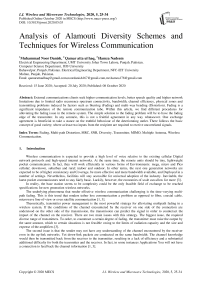Analysis of Alamouti Diversity Schemes and Techniques for Wireless Communication
Автор: Muhammad Noor Danish, Qamar Atta Ul Haq, Hamza Nadeem
Журнал: International Journal of Wireless and Microwave Technologies @ijwmt
Статья в выпуске: 5 Vol.10, 2020 года.
Бесплатный доступ
External communications clients seek higher communication levels, better speech quality and higher network limitations due to limited radio recurrence spectrum connectivity, bandwidth, channel efficiency, physical zones and transmitting problems induced by factors such as blurring (Fading) and multi-way bending (Distortion). Fading is a significant impedance of the remote communication tube. Within this article, we find different procedures for alleviating the fading issue in the remote system. The simple solution to the fading problem will be to have the fading edge of the transmitter. In any scenario, this is not a fruitful agreement in any way whatsoever. One exchange agreement is beneficial to take a stance on the truthful behaviour of the deteriorating outlet. There follows the basic concept of good variety; where at least two inputs from the recipient are required to receive uncorrelated signals.
Fading, Multi-path Distortion, MRC, SNR, Diversity, Transmitter, MIMO, Multiple Antenna, Wireless Communication
Короткий адрес: https://sciup.org/15017651
IDR: 15017651 | DOI: 10.5815/ijwmt.2020.05.03
Список литературы Analysis of Alamouti Diversity Schemes and Techniques for Wireless Communication
- Rappaport. D, “Wireless Communications Principles and Practice”, Eagle hood Cliffs,NJ:Printice Hall 1996.
- A.,Basharat, I.A., Khokhar, S., Murtaza, “CDMA versus IDMA for subscriber cell density” , International Conference on,Innovations in Information Technology, 2008. 16-18 Dec. 2008,pp 520 - 524
- S.M. Alamouti, “A simple transmit diversity technique for wireless communications”, IEEE J. Select. Areas Commun. 16 (8) (1998) 1451–1458.
- M. Moher and P. Guinand, "An iterative algorithm for asynchronous coded multiuser detection," IEEE Commun. Lett., vol. 2, Aug. 1998, pp. 229-231
- V.Tarokh, H.Jafarkhani, and A.R. Calderbank,"Space-time block coding for wireless communications: performance result" IEEEJ.selecte.Areas Commun., vol 17, no.3,Mar. 1999 pp. 451-460.
- A. Correia, “Transmit Diversity Schemes for WCDMA”, Wireless Personal Communications, 25: 2003, pp 65-85
- Hafeth Hourani "An Overview of diversity techniques in wireless communication systems" S-72.333 Postgraduate course in radio communication,2004
- W.C Jakes,Microwave Mobile Communications , Wiley New York 1974, pp. 417-426
- William C. Y. Lee , “Mobile Communications Design fundamentals”, Wiley Series in Telecommunications, Second edition,1993
- M.K. Simon, M.,S. Alouni, “A Unified Approach to the Performance Analysis of Digital Communication over generalized Fading Channels” , Proc. IEEE 86(9) ,1998,pp 1860-1877.
- W. C. Jakes, Ed., Microwave Mobile Communications. New York: Wiley, 1974.
- A. Wittneben, “Base station modulation diversity for digital SIMULCAST,” in Proc. 1991 IEEE Vehicular Technology Conf. (VTC 41st), May 1991, pp. 848–853.
- A. Wittneben, “A new bandwidth efficient transmit antenna modulation diversity scheme for linear digital modulation,” in Proc. 1993 IEEE International Conf. Communications (ICC’93), May 1993, pp. 1630–1634.
- N. Seshadri and J. H. Winters, “Two signaling schemes for improving the error performance of FDD transmission systems using transmitter antenna diversity,” in Proc. 1993 IEEE Vehicular Technology Conf. (VTC 43rd), May 1993, pp. 508–511.
- V. Tarokh, N. Seshadri, and A. R. Calderbank, “Space-time codes for high data rate wireless communication: Performance criteria and code construction,” IEEE Trans. Inform. Theory, Mar. 1998.


